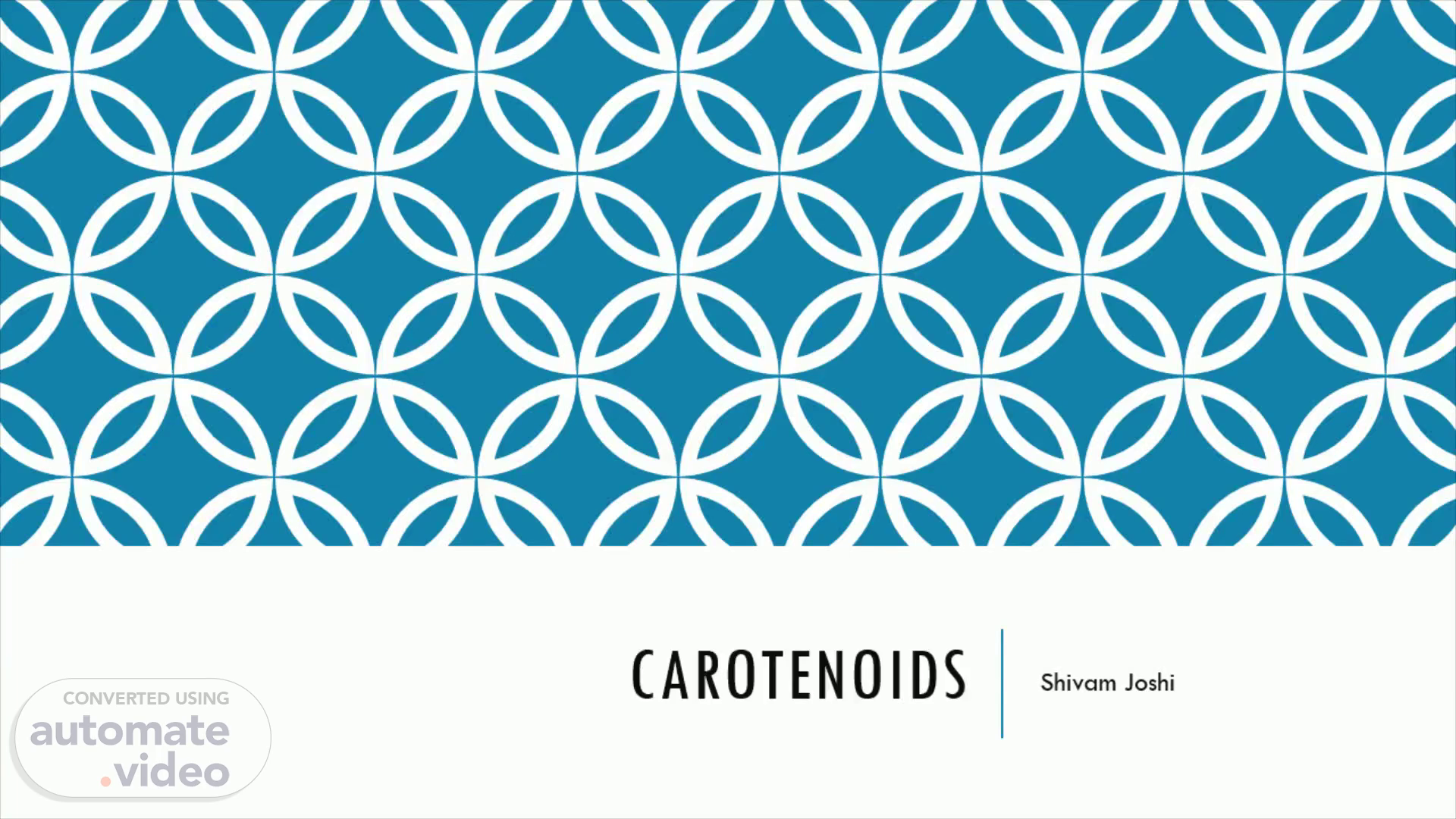Scene 1 (0s)
Carotenoids. Shivam Joshi.
Scene 2 (6s)
What is Carotenoids?. Carotenoids, also called tetraterpenoids, are organic plant pigments responsible for bright red, yellow and orange hues in many fruits and vegetables. These pigments play an important role in plant health. People who eat foods containing carotenoids get protective health benefits as well. Carotenoids are a class of phytonutrients ("plant chemicals") and are found in the cells of a wide variety of plants, algae and bacteria. They help plants absorb light energy for use in photosynthesis. They also have an important antioxidant function of deactivating free radicals — single oxygen atoms that can damage cells by reacting with other molecules..
Scene 3 (33s)
What is Carotenoids?. Carotenoids also act as antioxidants in the human body. They have strong cancer-fighting properties, according to the Physicians Committee for Responsible Medicine. Some carotenoids are converted by the body to vitamin A, which is essential to vision and normal growth and development. Carotenoids also have anti-inflammatory and immune system benefits and are sometimes associated with cardiovascular disease prevention..
Scene 4 (52s)
Sources of carotenoids. Carotenoid-containing foods are often red, yellow or orange, but not always. carrots, yams, sweet potatoes , papaya, watermelon , cantaloupe, mangos, spinach, kale , tomatoes, bell peppers and oranges are among the fruits and vegetables in which carotenoids can be found. Animals cannot manufacture carotenoids themselves; they have to get it in their diets. Carotenoids need to be consumed with a fat in order for the body to absorb them..
Scene 5 (1m 15s)
The carotenoid family. There are more than 600 types of carotenoids. The most common ones in the Western diet, and the most studied, are alpha-carotene, beta-carotene, beta-cryptoxanthin, lutein, zeaxanthin and lycopene, according to the Linus Pauling Institute. There are two broad classifications of carotenoids: carotenes and xanthophylls, said Premkumar . The difference between the two groups is chemical: xanthophylls contain oxygen, while carotenes are hydrocarbons and do not contain oxygen. Also, the two absorb different wavelengths of light during a plant’s photosynthesis process, so xanthophylls are more yellow while carotenes are orange..
Scene 6 (1m 43s)
Carotenes: Beta-carotene. Of the provitamin A carotenoids, beta-carotene is the most powerful when it comes to turning into vitamin A; twice as much beta-carotene becomes vitamin A than does alpha-carotene or beta-cryptoxanthin. Beta-carotene was the first and is the most widely studied of the carotenoids. It seems to be capable of both positive and negative effects, especially for smokers taking it as a supplement. Two studies of showed that smokers and former asbestos workers who took beta- carotene supplements increased their risk of lung cancer, according to the Linus Pauling Institute. Doctors currently advise smokers not to take beta-carotene supplements. Large amounts of beta-carotene from food, however, do not seem to carry this risk; the worst they can do is temporarily turn your skin orange, according to the National Institutes of Health ..
Scene 7 (2m 19s)
Carotenes: Beta-carotene. Cantaloupe, mangoes, papaya, carrots, sweet potatoes, spinach, kale and pumpkin are good sources of beta-carotene, said Premkumar . Beta-carotene gives orange foods their color; in fact, the word carotene comes from the Latin word for carrot. Beta-carotene may help protect against sunburn, according to a meta-analysis published in Photochemistry and Photobiology . The researchers looked at several studies and found that participants who took beta-carotene supplements for 10 weeks had lower rates of sunburn. For each month of additional supplementation, the protection level increased..
Scene 8 (2m 45s)
Carotenes: Beta-carotene. Beta-carotene may help lower the risk of metabolic syndrome, at least in middle-age and elderly men, a study published in the Journal of Nutrition found. Metabolic syndrome is characterized by high blood pressure, high blood sugar, abnormal cholesterol levels and excess fat around the waist. The men with the most beta-carotene intake had the lowest risk of metabolic syndrome, as well as reduced waist circumference. Scientists suspect this is the result of beta-carotene’s antioxidant activities. Early studies suggested that beta-carotene was associated with a reduced risk of lung cancer, according to a review published in the Journal of Nutrition . More recent studies have shown that relationship to be unreliable, although other carotenoids like alpha-carotene, lycopene and beta-cryptoxanthin have shown promise..
Scene 9 (3m 18s)
THANK YOU. Smiling Face with No Fill.
